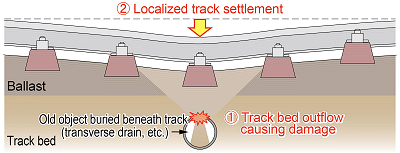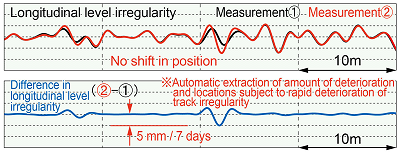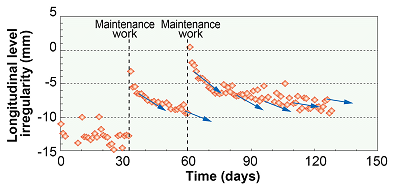12. Methods to detect and predict rapid localized deterioration of track irregularity
The collapse or failure of structures beneath a track can lead to roadbed caving or tamping insufficiency during track maintenance, which in turn can cause rapidly deteriorating track irregularity requiring immediate attention (Fig. 1). In order to detect the signs of rapid deterioration, RTRI developed a small, lightweight track inspection device that is mounted on commercial vehicles for high-frequency track condition monitoring. However, the waveforms collected on a daily basis vary in position along the railway track by a few meters. Therefore, although differences in waveforms measured on different days can be compared, it is very difficult to automatically identify which locations are suffering from rapidly deteriorating irregularity (Fig. 2).
A method was therefore developed using characteristics of high-frequency track monitoring data to allow automatic detection of rapidly deteriorating track irregularity by position correction: while shifting the waveform phases the phase with the largest correlation coefficient between waveforms was found, making it possible to reduce positional shift to within ±25cm along the railway track. By computing the difference between the corrected waveforms, a method was developed to automatically extract locations with rapidly deteriorating track irregularity using discrepancies in measured waveforms from different measurement days (Fig. 3).
Next, a method was devised to predict future track irregularity in locations where rapidly deteriorating track irregularity was detected: after each new measurement Bayesian inference is applied to consecutively update predicted track irregularity. The accuracy of the method makes it possible to predict gaps of ±1mm up to fifteen days ahead. This allows for example, early detection of locations subject to rapidly deteriorating track irregularity, facilitating the planning of appropriate maintenance work (Fig. 4). This newly developed position correction method was also integrated as a new function in the track maintenance and management system ‘LABOCS'.
Other Contents
- 10. Design method for concrete filled tube members with rectangular section
- 11. Tunnel lining crack detection method using deep learning or multi-layer neural network
- 12. Methods to detect and predict rapid localized deterioration of track irregularity
- 13. Development of new solid-bed track with resilient sleepers using shear-key to achieve efficient construction work
- 14. Profiling (through grinding) of aging rails based on X-ray diffraction analyses
- 15. Improving OCL connector fatigue resistance
- 16. Proposal for light weight high-rigidity car body structure
- 17. Reduction in manufacturing cost of C/C composite pantograph contact strips and clarification of their wear limit
- 18. Method for evaluating serviceable life and deterioration of electronic interlocking equipment
- 10. Design method for concrete filled tube members with rectangular section
- 11. Tunnel lining crack detection method using deep learning or multi-layer neural network
- 12. Methods to detect and predict rapid localized deterioration of track irregularity
- 13. Development of new solid-bed track with resilient sleepers using shear-key to achieve efficient construction work
- 14. Profiling (through grinding) of aging rails based on X-ray diffraction analyses
- 15. Improving OCL connector fatigue resistance
- 16. Proposal for light weight high-rigidity car body structure
- 17. Reduction in manufacturing cost of C/C composite pantograph contact strips and clarification of their wear limit
- 18. Method for evaluating serviceable life and deterioration of electronic interlocking equipment




